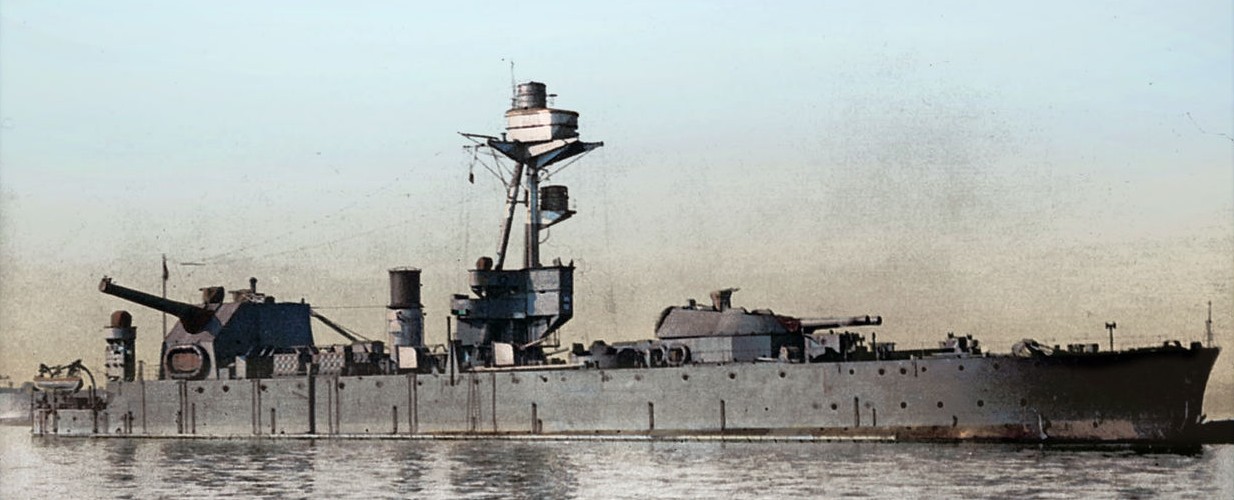In the real time line there were three single 18" guns produced for the Furious, two to arm the ship and one as a spare. Furious only ever had the B turret mounted, what should have been A turret was placed aboard HMS Lord Clive in a fixed position. Eventually the three guns were used as experimental weapons and sold for scrap, two in 1933, and one in 1947. None of the guns ever left the various proving grounds after World War One. The myth that two of them were sent to Singapore was just that a myth with no foundation.

HMS Lord Clive, 1918, with single 18" aft.
That does not suit me, so I change history. For the Fisherless RN, the 18"/40cal guns are built as experimental guns for the next generation of British battleship designs after the Majestic Class (12x15"). The UK went to the 18" to go one step further than what their spies were telling them was in the pipeline for other Navies. The US, Japan, Germany were all producing 16" ships and designs, the Royal Navy would go one better. The first three guns were built but the design teams decided on an 18"/45cal weapon for the new ship designs. The monitor class ships were in service and providing very good fire support to the seaward end of the Continental Army. One was sent out to Gallipoli and also did good work there. So a pair of single gun turrets were built to house two of the guns the third would be kept as a spare and/or experimental gun. The turrets would be fitted to advanced Erebus class ships with slightly larger overall dimensions.

The two ships Destruction and Volcano were completed in late 1919, where so many other types were cancelled and scrapped at the end of World War One. The Admiralty wanted these ships with their long range guns at sea. One went to the Black Sea to fight with the White Army, the other went to the Baltic to assist against the Soviet Revolution at the source at St Petersburg (soon to be renamed Leningrad). Both ships were able to sit back comfortably out of range of the Soviet guns and pound their targets to destruction. To help with accuracy, spotting from aircraft proved very helpful indeed and would be a forbear of things to come in twenty years time.
.png)
The later 1920's found the two ships back from the Russian campaigns and into the endless rotations of peace time servitude. Both Destruction and Volcano rotated in and out of the Atlantic and Mediterranean Fleets, with refits coming at regular intervals to update guns, gunnery control, and electronic equipment. By 1941 the two ships had received just about as much updating as the Admiralty felt was worth investing in these ships. They had up to date electronic aids, a decent heavy and light AA battery and the 18" gun outranged anything else in the Mediterranean. The Volcano had Crete to thank for its loss. The ineptitude of the Prime Minister and his obsession with the Balkans cost the Commonwealth Army, Navy and Air Force very dearly for going into Greece then trying to hold Crete as the Commonwealth forces were forced to retreat again. If Winnie had left his theater Commanders to do what was necessary instead of the micro management insisted on. Then the Italians and Germans would never have got a foot hold in North Africa. Generals Auchinleck and Wavell and their forces had the Italians on the run along the coast and would have forced them out of North Africa before the Germans could intervene, except for one thing. At the moment of Victory, Auchinlecks best forces are taken away to go to Greece. The Volcano with other ships including light cruisers and destroyers are in convoy carrying the retreating survivors from Crete when the ships were attacked by large forces from Fliegerkorps X. A cruiser, two destroyers and Volcano are sunk with other ships damaged and crippled and barely make it back to Alexandria.
The Destruction played its part in all of the major Mediterranean Sea battles, along the North African coast, on to Sicily, then up the boot of Italy, Anzio, Salerno, then taken out of the Med to join the bombardment forces for D Day, June 1944. From there the Destruction followed the Army up the coast of the English Channel and North Sea. 1945 found Destruction in the Baltic still providing fire support as the Army cleaned out pockets of die hard Nazis. June 1945 and the Destruction is at the Firth of Forth, laid up, awaiting its fate. Sold and scrapped at Inverkeithing 1946.
